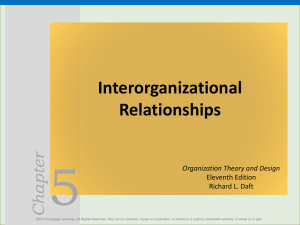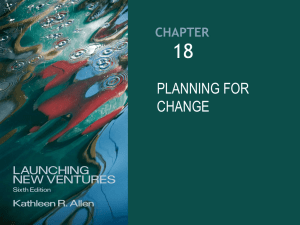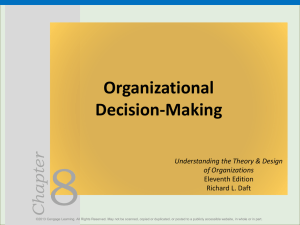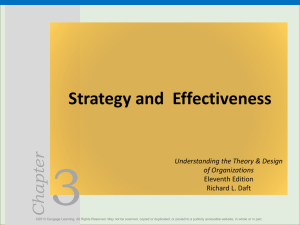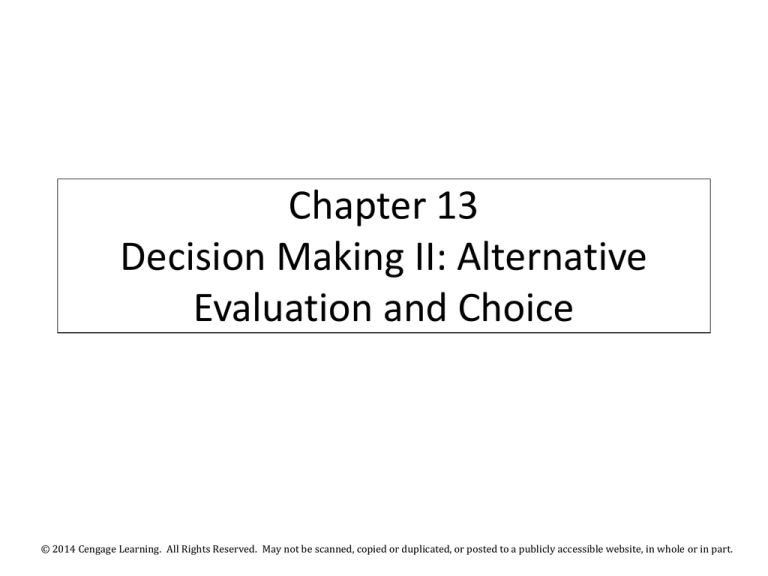
Chapter 13
Decision Making II: Alternative
Evaluation and Choice
© 2014 Cengage Learning. All Rights Reserved. May not be scanned, copied or duplicated, or posted to a publicly accessible website, in whole or in part.
Learning Outcomes
• Understand the difference between evaluative
criteria and determinant criteria
• Comprehend how value affects the evaluation
of alternatives
© 2014 Cengage Learning. All Rights Reserved. May not be scanned, copied or duplicated, or posted to a publicly accessible website, in whole or in part.
Learning Outcomes
• Explain the importance of product
categorization in the evaluation of alternatives
process
• Distinguish between compensatory and
noncompensatory rules that guide consumer
choice
© 2014 Cengage Learning. All Rights Reserved. May not be scanned, copied or duplicated, or posted to a publicly accessible website, in whole or in part.
© 2014 Cengage Learning. All Rights Reserved. May not be scanned, copied or duplicated, or posted to a publicly accessible website, in whole or in part.
Evaluative Criteria
• Attributes, features, or potential benefits that
consumers consider when reviewing possible
solutions to a problem
• Feature - Performance characteristic of an
object
• Benefit - Perceived favorable result that is
derived from the presence of a particular
feature
© 2014 Cengage Learning. All Rights Reserved. May not be scanned, copied or duplicated, or posted to a publicly accessible website, in whole or in part.
© 2014 Cengage Learning. All Rights Reserved. May not be scanned, copied or duplicated, or posted to a publicly accessible website, in whole or in part.
Determinant Criteria
• Determinant criteria - Evaluative criteria that
are related to the actual choice that is made
© 2014 Cengage Learning. All Rights Reserved. May not be scanned, copied or duplicated, or posted to a publicly accessible website, in whole or in part.
Value and Alternative Evaluation
• Hedonic criteria - Emotional, symbolic, and
subjective attributes or benefits that are
associated with an alternative
• Utilitarian criteria - Functional or economic
aspects associated with an alternative
• Bounded rationality - Perfectly rational
decisions are not always feasible due to
constraints found in information processing
© 2014 Cengage Learning. All Rights Reserved. May not be scanned, copied or duplicated, or posted to a publicly accessible website, in whole or in part.
Types of Evaluation Processes
• Affect-based
evaluation
– Evaluate products
based on the overall
feeling that is evoked
by the alternative
• Attribute-based
evaluation
– Evaluate alternatives
across a set of
attributes that are
considered relevant
to the purchase
situation
© 2014 Cengage Learning. All Rights Reserved. May not be scanned, copied or duplicated, or posted to a publicly accessible website, in whole or in part.
Product Categorization and Criteria
Selection
• Product categories - Mental representations
of stored knowledge about groups of products
• Category levels
– Superordinate
– Subordinate
© 2014 Cengage Learning. All Rights Reserved. May not be scanned, copied or duplicated, or posted to a publicly accessible website, in whole or in part.
© 2014 Cengage Learning. All Rights Reserved. May not be scanned, copied or duplicated, or posted to a publicly accessible website, in whole or in part.
Perceptual and Underlying ¬Attributes
• Perceptual attributes Visually apparent and
easily recognizable
• Underlying attributes Readily apparent and
can only be learned
through experience
with the product
– Signal - Characteristic
that allows a consumer
to diagnose something
distinctive about an
alternative
© 2014 Cengage Learning. All Rights Reserved. May not be scanned, copied or duplicated, or posted to a publicly accessible website, in whole or in part.
Factors Determining Evaluative Criteria
Used
Situational Influences
Product Knowledge
Expert Opinions
Social Influences
Online Sources
Marketing Communications
© 2014 Cengage Learning. All Rights Reserved. May not be scanned, copied or duplicated, or posted to a publicly accessible website, in whole or in part.
Issues That Affect Consumer
Judgments
•
•
•
•
•
Just noticeable difference
Attribute correlation
Quality perceptions
Brand name associations
Consumer personality
© 2014 Cengage Learning. All Rights Reserved. May not be scanned, copied or duplicated, or posted to a publicly accessible website, in whole or in part.
© 2014 Cengage Learning. All Rights Reserved. May not be scanned, copied or duplicated, or posted to a publicly accessible website, in whole or in part.
Consumer Choice: Decision Rules
• Compensatory rules Allow consumers to
select products that
may perform poorly on
one attribute by
compensating for the
poor performance by
good performance on
another attribute
• Noncompensatory
rules - Used, strict
guidelines are set prior
to selection, and any
option that does not
meet the specifications
is eliminated from
consideration
© 2014 Cengage Learning. All Rights Reserved. May not be scanned, copied or duplicated, or posted to a publicly accessible website, in whole or in part.
Noncompensatory Models
Conjunctive Rule
Disjunctive Rule
Lexicographic Rule
Elimination-by-aspects Rule (EBA)
© 2014 Cengage Learning. All Rights Reserved. May not be scanned, copied or duplicated, or posted to a publicly accessible website, in whole or in part.
© 2014 Cengage Learning. All Rights Reserved. May not be scanned, copied or duplicated, or posted to a publicly accessible website, in whole or in part.
Retail Outlet Selection
• Several factors influence the choice of retail
outlet including objective and subjective
criteria such as:
– Product variety
– Store image
– Location
– Service
– Product quality
© 2014 Cengage Learning. All Rights Reserved. May not be scanned, copied or duplicated, or posted to a publicly accessible website, in whole or in part.





